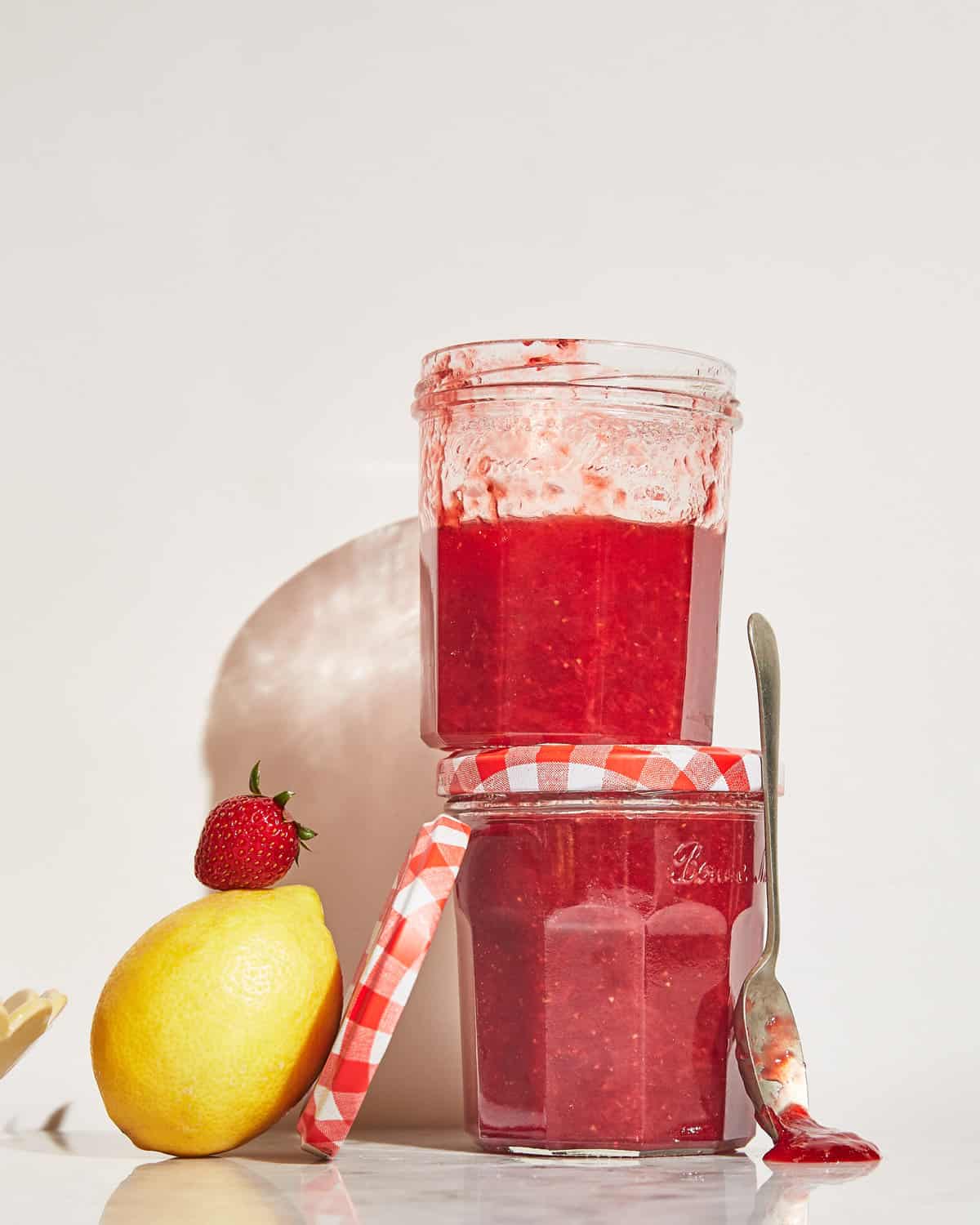
Whether you’re inundated with a glut of home-grown strawberries or just fancy giving jam making a go, this jam recipe is easy and delicious.
Strawberries are a naturally low-pectin fruit, meaning usually you’re told to add pectin (or to use jam sugar which contains pectin) as this is required to get the jam to thicken and ‘set’ into a spreadable form. However, I’ll show you today how to make strawberry jam without needing to add pectin! All you need are strawberries, lemon and sugar.
Lemons are naturally high in pectin so adding a wedge to the pot as the jam boils draws that pectin out, helping our jam to set. We also add a bit of lemon juice which reduces the pH of the jam (i.e. makes it more acidic) which helps preserve the jam. I usually find supermarket strawberry jam is too sweet/not sharp enough so having this homemade strawberry jam as been incredible as I add a little extra lemon juice than necessary to give it that moreish tartness. If you prefer it to be less tart, just reduce the lemon juice slightly.
As I prefer a more fruit-forward jam, I use the lowest % of sugar I can get away with, doing 50% the weight of fruit in sugar (e.g. 600g fruit to 300g sugar). This gives us a lovely strawberry-heavy flavour that is lower in sugar than standard strawberry jam, but has enough sugar to be stable at room temperature (as long as it’s in a sterilised & sealed jar, that is!).
The recipe card is directly below but if you’re a newbie to making jam I encourage you to scroll to just under the card as I have step-by-step images there. It can be a little daunting trying to figure out when jam is cooked enough so I find it’s helpful to show what to look for at different points so you know you’re on the right track. This will also help you not overcook your jam which can lead to it losing that fresh flavour and becoming too thick.
Other jam recipes:

Strawberry Jam (no pectin)
Ingredients
- 600 g strawberries (fresh or frozen)
- 300 g granulated sugar
- 1/4 lemon
- 3 to 4 tbsp lemon juice
Instructions
- If the berries are frozen, add to a large pot at room temperature. If fresh, hull and quarter the strawberries then add to a large pot. NB: Choose a pot which leaves you plenty of room above the berries; jam bubbles up as it cooks so you need some headroom to prevent it overflowing!600 g strawberries
- Add the sugar and wedge of lemon to the pot of strawberries. Stir together and leave to sit for at least 30 minutes (or even overnight in the fridge for the best result!)- you're looking for the berries to be swimming in juice and for all/most of the sugar to have been dissolved. This helps kick-start the jam-making process and gives you a really nice combo of juicy jam with fruity chunks in the finished product.300 g granulated sugar, 1/4 lemon
- Add the lemon juice (use more if you prefer a sharper jam) and mash the berries by hand, squishing them in the pot. Mash to the size that you'd like the fruit to be in the final jam. If you prefer a completely smooth jam, use a hand blender to blitz until smooth (careful to avoid blending the lemon wedge!).3 to 4 tbsp lemon juice
- Place a small plate in the freezer before you start cooking the jam, you'll use this for the 'wrinkle test' later.
- Sterilise your jars: Thoroughly clean your jam jars and lids inside and out with hot soapy water. Place the jars upside-down on a baking tray and into a 180°C oven to dry out (around 10-15 minutes). It's good to start this just before you make your jam so the jars are still hot when you add the jam!
- Cook the fruit over a medium heat on the stove, stirring often to prevent the jam catching and burning on the base of the pot. Foam will form on the surface at first – if you want to have a super clear jam at the end, skim this off and discard. Otherwise ignore the foam (I do!), it'll mostly subside but may make your jam slightly cloudy.
- After ~10-15 minutes, the foam will have subsided and the jam will look glossy with big shiny bubbles.
- The wrinkle test: to test if the jam is ready, take that small plate out of the freezer and place a small amount of jam onto it. Let it sit for ~10 seconds then push your finger through it. It should have a gently wrinkled appearance on its surface as you push your finger through (see pics in blog post below). It can be kind of subtle so you can also check if the jam runs together after you've pushed your finger through it – if a line remains, your jam is ready! If the line disappears and/or there's no wrinkle, keep cooking the jam for a few minutes longer and test again the same way.
- Once you're happy with the texture of the jam, remove the wedge of lemon then pour the hot jam into the hot jam jars, leaving about 1-2cm of headroom at the top of the jars. Screw on the lids and set upside-down on a baking tray to cool. Once cool, turn right side up and store somewhere cool and dark for up to 1 year.
How to make strawberry jam – step-by-step images:










FAQs
Does strawberry jam need pectin?
Pectin is a long-chain soluble fibre which is present in all fruit and veg (it makes up part of plant cell walls!). When making jam, boiling the fruit with sugar releases the pectin which then helps to thicken the jam. As the jam cools, the pectin ‘sets’, a bit like how gelatine makes fruit jelly ‘set’. Strawberries are a low-pectin fruit meaning that if you simply boiled up strawberries and plain sugar, your jam probably wouldn’t set properly. Some strawberry jams (especially commercial ones) will combat this by adding granulated/liquid pectin which has been extracted from fruits.
Making strawberry jam without needing pectin
We can bypass the need for buying granulated/liquid pectin by including a wedge of lemon in the jam as it boils. Citrus fruits are really high in pectin (especially in the white pith of the fruits), so including them in your jam is a natural, easy way to include some extra pectin in the jam. Just remember to remove the lemon wedge before jarring your jam!

Why is my strawberry jam runny?
This is most likely down to not cooking the jam for long enough. If the jam is undercooked, the pectin won’t have become ‘activated’, plus the jam may not have reduced enough, so your jam won’t set. It’s a particular pressure point for strawberry jam as strawberries are low in pectin.
Another thing to note is that the jam will be runny when it’s hot, even when it’s been properly cooked. As the jam cools down, it will thicken up and set.
You may find that homemade strawberry jam is just runnier than what you’re used to getting from the supermarket as they usually add extra pectin. If this is something that bothers you then switch or jam sugar or add liquid/granulated pectin (e.g. Certo), using the directions on the packet to guide you in how much to add.
How much sugar do you need to make strawberry jam?
Generally when making jams, you can go with between 40 to 100% the weight of fruit in sugar. Supermarket jams and more traditional recipes (ike this one by Mary Berry) are usually using 100% the weight of fruit in sugar (i.e. equal weights of each).
I tend to find these too sweet and that the flavour of the fruit gets a bit lost so I like to use as little sugar as possible. Lower pectin fruits tend to need a bit more sugar so I go with 50% sugar to fruit (which is the same ratio that Jamie Oliver uses). So for this recipe, I use 600g fruit to 300g sugar. This means your jam may be slightly less thick than what you’re used to buying (especially as we’re not using jam sugar), so just be aware that this is a consequence of having a fruitier jam.
Does strawberry jam need to be refrigerated?
As long as your jars are properly sterilised and sealed, you shouldn’t need to refrigerate un-opened jars of jam. Once a jar has been opened, you should store it in the fridge otherwise it may become mouldy.
Can strawberry jam be made with frozen strawberries?
Yes! This is a great idea for when strawberries are out-of-season as frozen fruit is usually picked and frozen when it’s in season (meaning it’ll taste better and probably be cheaper than buying out-of-season, fresh berries).
I just let the strawberries defrost as they’re macerating with the sugar.
Do I need to skim the foam from my jam?
As you cook your strawberry jam you may notice foam forming on the top. Many recipes will tell you to skim this off and discard it. Now, you can do this and it’ll help to make your jam clearer. However, I think it’s basically a waste of time and a waste of jam! I just let it keep boiling and most of the foam subsides. You’ll probably have a bit of it left when you’re jarring the jam but all it does is make your jam look a bit more opaque. Some recipes, like this one by Delia, also swear by adding a little bit of butter to the jam to eliminate the foam. You can do this and it does help, but it means the jam is no longer vegan and may have a slightly altered flavour.
Uses for strawberry jam
- make the British school dinner classic, cornflake tart
- use in the bottom of a bakewell tart
- swirl into fruited muffin batters
- mix with fresh fruit in the filling for a crumble
- and, my favourite, serve with homemade scones (or even vegan scones)!

